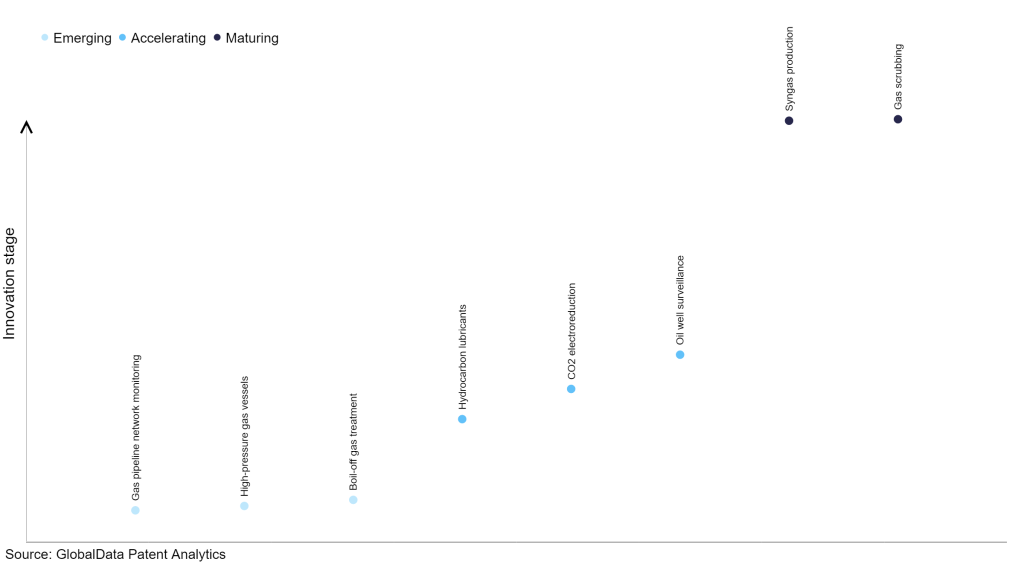The oil & gas industry continues to be a hotbed of patent innovation. Activity is driven by advances in cryogenic technology and equipment, and the need to lower costs and reduce environmental emissions, and the growing importance of technologies such as machine learning, digitalization, and artificial intelligence. In the last three years alone, there have been over 327,000 patents filed and granted in the oil & gas industry, according to GlobalData’s report on Innovation in oil & gas: cryogenic gas separation. Buy the report here.
However, not all innovations are equal and nor do they follow a constant upward trend. Instead, their evolution takes the form of an S-shaped curve that reflects their typical lifecycle from early emergence to accelerating adoption, before finally stabilizing and reaching maturity.
Identifying where a particular innovation is on this journey, especially those that are in the emerging and accelerating stages, is essential for understanding their current level of adoption and the likely future trajectory and impact they will have.
65+ innovations will shape the oil & gas industry
According to GlobalData’s Technology Foresights, which plots the S-curve for the oil & gas industry using innovation intensity models built on over 201,000 patents, there are 65+ innovation areas that will shape the future of the industry.
Within the emerging innovation stage, gas pipeline network monitoring, high-pressure gas vessels, and boil-off gas treatment are disruptive technologies that are in the early stages of application and should be tracked closely. Hydrocarbon lubricants, CO2 electroreduction and oil well surveillance are some of the accelerating innovation areas, where adoption has been steadily increasing. Among maturing innovation areas are syngas production and gas scrubbing, which are now well established in the industry.
Innovation S-curve for the oil & gas industry

Cryogenic gas separation is a key innovation area in oil & gas
Cryogenic gas separation is a process used to remove certain gases, such as carbon dioxide, hydrogen, and methane, from a feed gas stream by cooling it to very low temperatures and allowing the gases to condense and separate. This method of separation is commonly used in industries such as oil and gas to produce purified gases for further use or sequestration.
Cryogenic gas separation is observed as the preferred technology for generating high-purity gases.
GlobalData’s analysis also uncovers the companies at the forefront of each innovation area and assesses the potential reach and impact of their patenting activity across different applications and geographies. According to GlobalData, there are 35+ companies, spanning technology vendors, established oil & gas companies, and up-and-coming start-ups engaged in the development and application of cryogenic gas separation.
Key players in cryogenic gas separation – a disruptive innovation in the oil & gas industry
‘Application diversity’ measures the number of applications identified for each patent. It broadly splits companies into either ‘niche’ or ‘diversified’ innovators.
‘Geographic reach’ refers to the number of countries each patent is registered in. It reflects the breadth of geographic application intended, ranging from ‘global’ to ‘local’.
Patent volumes related to cryogenic gas separation
Source: GlobalData Patent Analytics
Air Liquide is one of the leading patent filers in cryogenic gas separation industry. It has extensive experience in the separation of cryogenic gases. It developed an innovative technology called Crycocap for CO2 capture, while increasing the yield of H2. The company has also engineered solvent-based technologies such as amine to capture CO2 from flue or synthesis gas. Some other key patent filers in cryogenic gas separation include Linde and BP.
In terms of application diversity, Air Liquide leads the pack, while BP and Linde stood in the second and third positions, respectively. By means of geographic reach, 8 Rivers Capital held the top position, followed by Siemens and General Electric.
Cryogenic gas separation is a promising alternative to reduce emissions and reduce carbon footprint. Another key driver for the adoption of this technology is the production of gases with high purity.
To further understand the key themes and technologies disrupting the oil & gas industry, access GlobalData’s latest thematic research report on Oil & Gas.
Data Insights
From

The gold standard of business intelligence.
Blending expert knowledge with cutting-edge technology, GlobalData’s unrivalled proprietary data will enable you to decode what’s happening in your market. You can make better informed decisions and gain a future-proof advantage over your competitors.



